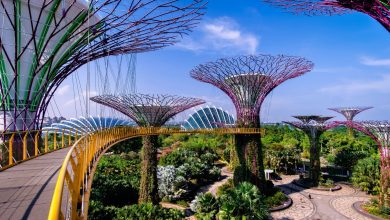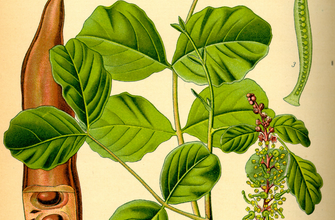Drip irrigation: What is it and how does it work? Types of drip irrigation and advantages
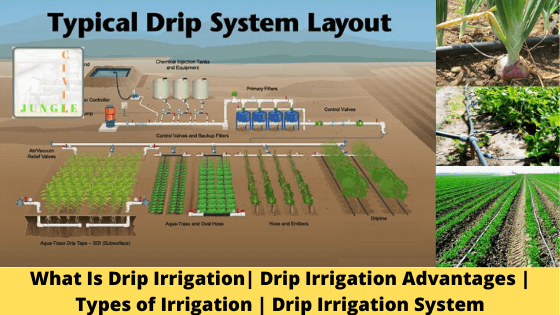
Drop -by-drop irrigation is one of the most widely used automatic systems for orchard and garden irrigation. In today’s post we will see what are the components of a drip irrigation kit and how to install it.
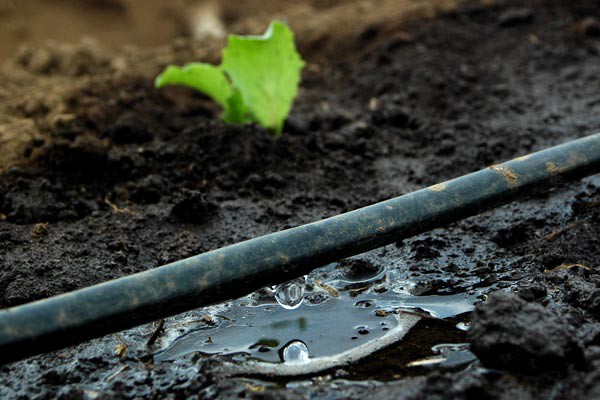
We will talk about the importance of drip irrigation in orchards, where this is one of the most used irrigation systems due to its many advantages. The benefits of drip irrigation are due, among other things, to saving water since drop-by-drop distribution is highly recommended for horticultural plants, flowers and other typical garden plants.

What is drip irrigation or drip irrigation
Drip irrigation is a high-efficiency irrigation method characterized by frequent application of small amounts of localized water near plant roots.

One of the main advantages of drip irrigation is that with this system water consumption is greatly reduced, since it is only applied drop by drop through drippers or emitters. The drippers release a small amount of water, although enough for the good growth of the plants in the garden.
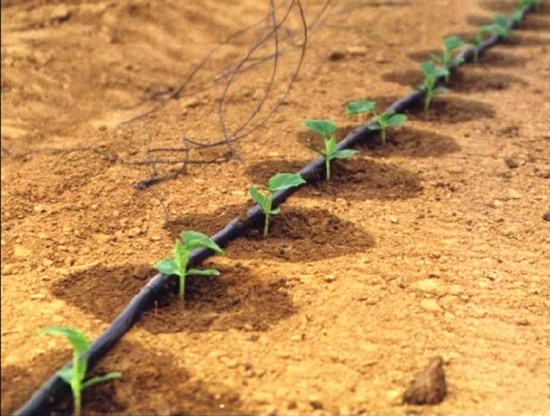
The drippers are usually inserted or punctured in a flexible polyethylene pipe at a greater or lesser distance from each other depending on the separation of the plants in the orchard (for most horticultural crops, one dripper per plant is sufficient).
There are also drip irrigation pipes with built-in drippers (like the one in the photo above), but if we opt for this type of installation we must ensure that the distance between drippers is adequate for the placement of our plants.
Advantages and disadvantages
Almost all are advantages with the use of this irrigation system in the orchard. Below we will see the benefits of using drip irrigation and the possible risks or disadvantages of drip irrigation (which, although few, also has some «cons»).
✅ Advantages of the drip system for the orchard
- Irrigation frequency is increased and water is applied exactly where plants need it (near the roots), thus promoting growth. Vegetables, in general, grow best when the substrate remains constantly moist and does not suffer «water stress». Drip irrigation provides a small amount of water so that the soil does not puddle, but more frequent irrigations mean that the root zone is always moist.
- Contrary to surface irrigation, such as furrow irrigation, dripping represents significant water savings since there are very few losses due to evaporation and surface runoff (water that circulates along the surface of the soil and does not penetrate into the on the substrate).
- As it is an automatic system, watering the orchard is more comfortable, less laborious. If we connect an irrigation programmer to the outlet of the faucet or water intake, we will not even have to be physically in the place for the drip irrigation to start, which represents a significant saving of time and effort.
- The detrimental effects on the soil are less than in other types of irrigation: less erosion (because the water does not circulate on the surface of the soil) and less loss of nutrients due to washing or deep infiltration (due to the lower speed and quantity of water applied at each irrigation).
- Weed reduction around crops. As the water is applied directly in the vicinity of each plant in the garden, adjacent areas are not wetted and there is less chance for weeds to thrive.
- For its installation, earthworks are not necessary, as in the case of furrow irrigation or the method of buried pipes.
- It is very versatile: it adapts to any type of terrain and slope. In addition, by modifying the number of drippers, the irrigation frequency and the amount of water, it can be used to irrigate all kinds of garden plants and fruit trees.
- The drip system can be used for the application of liquid fertilizers in the irrigation water (fertigation or fertigation), which saves time in the cultivation of the orchard.
- Drip irrigation prevents fungal diseases. Since the water is applied a few millimeters from the soil, the stems and leaves of the plants are not wetted, which minimizes the chances of fungal growth.
❌ Disadvantages of drip irrigation
- It is more expensive: although in the long run it is compensated by the saving of water and time, the initial cost of the installation is higher than in other types of irrigation.
- Obstruction of drippers: if the water has impurities, too many salts, or if the drippers are not of good quality or are very worn, they can become clogged and this prevents the flow of irrigation water.
- To avoid the above risk, several water filters may be necessary, which means an increase in the budget for the installation of the drip irrigation system.
- It is a fixed irrigation system, so once it is installed, the soil cannot be tilled. If any work such as weeding is carried out, it must be done with great care so as not to damage the pipes or drippers.
How the drip irrigation system works and how to install it
The water leaves the irrigation head (which starts from a running water tap or a tank) and circulates under pressure through distribution pipes until it reaches the emitters or drippers, where it loses pressure and speed so that the output is a drop. by drop
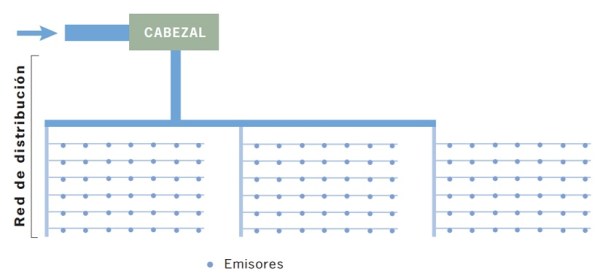
Drip irrigation kit for the orchard
The drip irrigation installation will start from a tap or water intake or, if there is none nearby, from a reservoir or pond. (If the orchard is small, a 15-20 liter drum will suffice, which we will fill every time it runs out).
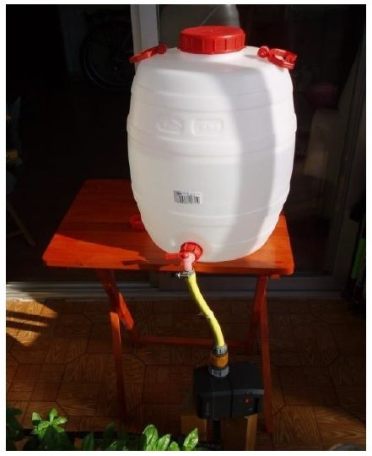
The components of a drip irrigation installation are basically: the irrigation head, the pipes or water distribution network, and the emitters.
- Irrigation head: it is made up of several elements such as the filters, the pump or the pressure regulator (depending on whether the system starts from a pool or tank or from a tap, respectively) and a solenoid valve that automates the irrigation. For small gardens, commercial irrigation controllers that can be purchased at any garden store come with all of these components included.
- Irrigation distribution network: the complexity of the system of pipes and drip tubes depends on the arrangement of the plants and the size of the orchard (we will see some examples in the last section). Elbows and tees will also be needed for the unions and branches, as well as plugs for the end of the drip lines.
- Droppers: there are many types. You can choose larger or smaller size / flow drippers depending on the needs of the plant. In addition, they can be inserted into the drip tubes or there are independent ones that can be «punctured» at any point on the drip tubes.
How to make a drip irrigation installation
As a picture is worth a thousand words, I have been looking for videos that explain in an easy way how to make a drip irrigation.
Without wanting to promote the French multinational (which does not pay us for it…), I leave you with this practical tutorial on how to set up a drip irrigation system step by step:
Types of drip irrigation
Below we will see some examples of drip irrigation installations. (If you know or have installed drip irrigation in another way, you can also tell us and leave photos in the comment thread, at the end of the post).
Drip irrigation on terraces and roofs
As seen in the video above, the drip irrigation system on terraces must be adapted to the layout of our cultivation containers.
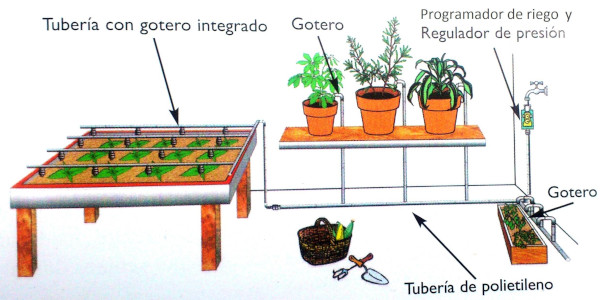
Through cuts and joints, we will shape the installation by taking the drip pipes to the different pots and cultivation tables.
Installation of drip irrigation for a terraced orchard
The scheme for installing terrace drip irrigation is very simple. Depending on the number of terraces or sections of the orchard, the irrigation units will be installed.
Depending on this, the primary pipe will have more or less branches of secondary and/or tertiary pipes. From the latter, the dripper pipes or “drip sides” start, which are the ones in which the emitters are inserted. In the case of irrigating vegetables with a drip system, low flow drippers should be chosen (from 1 to 4 liters per hour).
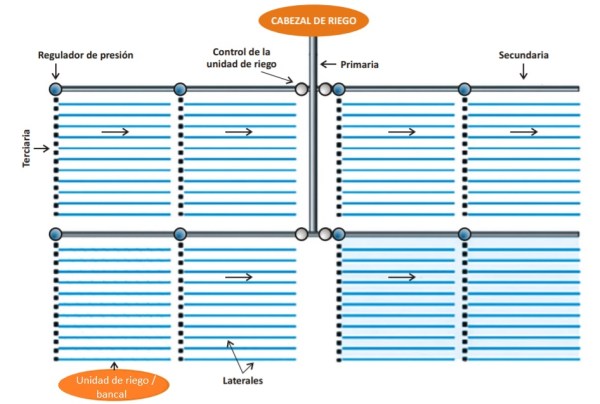
It is important to calculate, based on the number of drippers, the flow that the primary and secondary pipes will carry in order to choose the appropriate diameters.
If the vegetables on the different beds do not require the same amount of water, small taps can be installed at the start of the secondary and tertiary pipes to turn off/on the irrigation independently on each bed («irrigation unit control» in The imagen up).
Drip irrigation for fruit trees
In the case of drip irrigation for fruit trees, higher flow drippers must be installed than those used for vegetables and aromatics (those of 8 and 16 l/h are usually used).
As we have seen, depending on the water needs and the size of the crops, it may be necessary to place several drippers per plant. For large fruit trees, up to eight drippers per tree may be required.

For a more uniform irrigation that covers the entire root system, the dripper pipes that start from the distribution pipe are usually arranged in a circle around the trunk. In this case it is important, to avoid vascular diseases or the proliferation of fungi, that the drops that come out of the drippers do not directly touch the trunk of the trees.
Drip irrigation by exuding tape
Drip irrigation or drip tape irrigation is a type of drip irrigation. It has the particularity that, unlike the drip irrigation system, the drops do not come out of emitters or drippers separated by a certain distance, but instead cross the surface of the emitting pipe or exuding tape (which is porous) along its entire length. length.
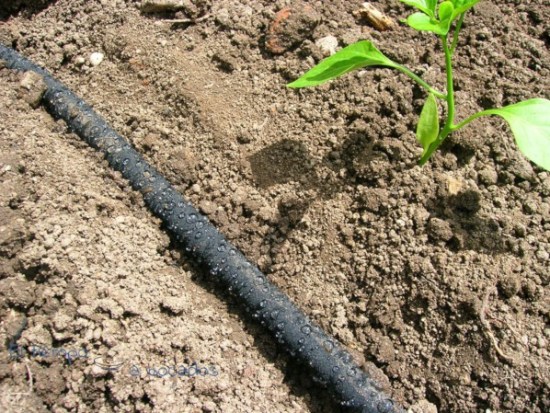
In the post Exuding tape or Irrigation by exudation: advantages and installation we saw more details about this type of localized irrigation.
References
- WWF Spain, 2009. Manual of good irrigation practices. WWF proposals for an efficient use of water in agriculture, Oct. 2009. With the support of the Ministry of the Environment, Marine and Rural Environment.
- Fernándes de Sousa, MM & García González de Lena, G., 2010. The localized irrigation system. Agrifood Technology, nº 14, pag-25-32.
- Demin, PE, 2014. Contributions to improve the management of irrigation systems. Irrigation Methods: Fundamentals, Uses, and Adaptations. National Institute of Agricultural Technology. Catamarca Regional Center, Argentina.
- Monge Redondo, MA, 2016. Pressure Regulators for Irrigation. iWater Knowledge.

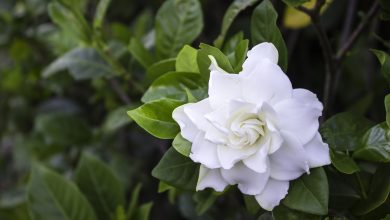
![Photo of Indoor Palm Tree Care: [Soil, Moisture, Pruning and Problems]](https://www.complete-gardening.com/wp-content/uploads/2021/06/51Xvo2oBj2L._SL500_-348x220.jpg)
